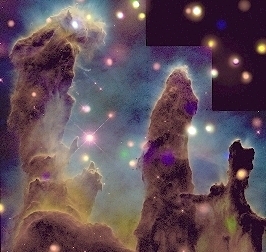
 A Corrected View Of the 'Pillars of Creation!'. An iconic image of modern astronomy -the famed 'Pillars of Creation', in the Eagle Nebula (M16)- which had been taken by the Hubble Space Telescope in 1995, has been revisited by the Chandra X-Ray Observatory, this NASA telescope working in the X-rays. This pillars of gas were thought to be the place of star formation, as the study in the X-rays is showing that the M16 nebula might well has passed its star-forming prime. The study saw few X-ray sources in the pillars only -that is two of them, on atop the left, the other atop the central pillar. It seems like the star formation in the Eagle Nebula peaked several millions year ago. The Chandra Telescope, on the other hand found that the 'evaporating gaseous globules,' or EGGs, those pockets of gas extruding from the pillars and believed to be places were stars are forming, proved, for most of them, that they don't contain enshrouded stars. Only 4 of them might be bound to yield a star. M 16 (or NGC 6611) is a cluster and nebula, of the 6th magnitude, to be found in the constellation Serpens, the Serpent, near the border with Scutum, the Shield.
picture courtesy NASA/CXC/U.Colorado/Linsky et al. (X-ray), NASA/ESA/STScI/ASU/J.Hester & P.Scowen (optical)
A Corrected View Of the 'Pillars of Creation!'. An iconic image of modern astronomy -the famed 'Pillars of Creation', in the Eagle Nebula (M16)- which had been taken by the Hubble Space Telescope in 1995, has been revisited by the Chandra X-Ray Observatory, this NASA telescope working in the X-rays. This pillars of gas were thought to be the place of star formation, as the study in the X-rays is showing that the M16 nebula might well has passed its star-forming prime. The study saw few X-ray sources in the pillars only -that is two of them, on atop the left, the other atop the central pillar. It seems like the star formation in the Eagle Nebula peaked several millions year ago. The Chandra Telescope, on the other hand found that the 'evaporating gaseous globules,' or EGGs, those pockets of gas extruding from the pillars and believed to be places were stars are forming, proved, for most of them, that they don't contain enshrouded stars. Only 4 of them might be bound to yield a star. M 16 (or NGC 6611) is a cluster and nebula, of the 6th magnitude, to be found in the constellation Serpens, the Serpent, near the border with Scutum, the Shield.
picture courtesy NASA/CXC/U.Colorado/Linsky et al. (X-ray), NASA/ESA/STScI/ASU/J.Hester & P.Scowen (optical)
 Les Piliers de la Création revus et corrigés
Les Piliers de la Création revus et corrigés
Une image-icône de l'astronomie moderne a été revue et corrigée. Le télescope Hubble, en 1995, avait capturé l'image célèbre de ces piliers de gaz et de poussière, dans la nébuleuse de l'Aigle (M16). Surnommés les "Piliers de la Création", ils étaient censés être la représentation nec plus ultra de la formation d'étoiles. Le télescope Chandra, le télescope de la NASA dans les rayons X, vient de remettre en question cette vue. Il semble bien que la nébuleuse M16 ait en fait dépassé le pic de sa formation d'étoiles, qui aurait eu lieu il y a quelques millions d'années. L'étude, en effet, n'a trouvé que deux sources de rayons X -au sommet de chacun des piliers respectivement! Le télescope Chandra, de plus, a permis de voir que les "EGGs" ("evaporating gaseous globules"), ces poches de gaz qui sont rattachées aux piliers et que l'on pensait le lieu de la formation d'étoiles, se sont avérés, pour la plupart, ne pas contenir d'étoile. Seuls 4 d'entre eux pourraient finalement donner naissance à une étoile. La nébuleuse M16 (aussi: NGC 6611) est un amas et une nébuleuse, de magnitude 6, qui se trouve dans la constellation du Serpent, près de la frontière avec l'Ecu. image dans les rayons X: NASA/CXC/U.Colorado/Linsky et al.; image dans le visible: NASA/ESA/STScI/ASU/J.Hester & P.Scowen
Website Manager: G. Guichard, site 'Amateur Astronomy,' http://stars5.6te.net. Page Editor: G. Guichard. last edited: 12/28/2010. contact us at ggwebsites@outlook.com


![]() Les Piliers de la Création revus et corrigés
Les Piliers de la Création revus et corrigés